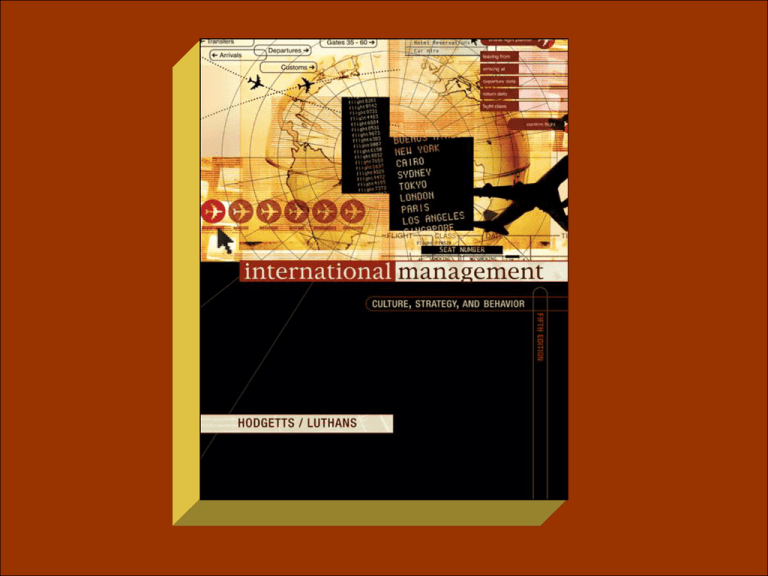
6-1
McGraw-Hill/Irwin
© 2003 The McGraw-Hill Companies, Inc.,All Rights Reserved.
6-2
International Management,
5th ed.
Part Two:
The Role of Culture
McGraw-Hill/Irwin
© 2003 The McGraw-Hill Companies, Inc.,All Rights Reserved.
6-3
Hodgetts
and Luthans
International
Management,
5th ed.
Chapter Six
Managing Across Cultures
McGraw-Hill/Irwin
© 2003 The McGraw-Hill Companies, Inc.,All Rights Reserved.
Objectives of the Chapter
6-4
EXAMINE the impact of globalization and
national responsiveness on international
strategic management
DISCUSS cross-cultural differences and
similarities
REVIEW cultural differences in select
countries and regions, and note some of the
important strategic guidelines for doing
business in each
McGraw-Hill/Irwin
© 2003 The McGraw-Hill Companies, Inc.,All Rights Reserved.
Strategy for Managing
across Cultures
6-5
MNC strategies must address the cultural
similarities and differences in their varied markets
Globalization
Production and distribution of products and services of
a homogeneous type and quality on a worldwide basis
National responsiveness
Need to understand the different consumer tastes in
segmented regional markets and respond to different
national standards and regulations imposed by
autonomous governments and agencies
Need to adapt tools and techniques for managing the
local workforce
McGraw-Hill/Irwin
© 2003 The McGraw-Hill Companies, Inc.,All Rights Reserved.
Figure 6-1
Globalization vs. National Responsiveness
6-6
Globalization (integration)
National responsiveness (differentiation)
McGraw-Hill/Irwin
High
Low
High
Globalization
strategy
Mixed strategy
(Transnational
strategy)
Low Mixed strategy
(International
strategy)
National
responsiveness
(Multi-domestic
strategy)
© 2003 The McGraw-Hill Companies, Inc.,All Rights Reserved.
6-7
Managing across Cultures (cont.)
Meeting the Challenge
Globalization imperative
Belief that one worldwide approach to doing business is the
key to both efficiency and effectiveness
Factors that help develop strategies for different cultures
Diversity of worldwide industry standards
Continual demand by local customers for differentiated products
Importance of being an insider
Difficulty of managing global organizations
Need to allow subsidiaries to use their own abilities and talents
and not be restrained by headquarters
Challenges of adjusting global strategies to regional markets
MNC must stay abreast of local market conditions
MNC must know the strengths and weaknesses of its subsidiaries
MNC must give subsidiary autonomy to address local demands
McGraw-Hill/Irwin
© 2003 The McGraw-Hill Companies, Inc.,All Rights Reserved.
Cross-Cultural Differences
and Similarities
6-8
Parochialism
Tendency to view the world through one’s own
eyes and perspectives
Problem for managers from advanced economies
who believe that their knowledge is sufficient for
doing business in less developed countries
Simplification
Process of exhibiting the same orientation
toward different culture groups
Orientation reflects one’s basic culture
McGraw-Hill/Irwin
© 2003 The McGraw-Hill Companies, Inc.,All Rights Reserved.
6-9
Table 6-1
Six Basic Cultural Variations
Orientations
What is the nature of people?
What is person’s relationship to nature?
What is person’s relationship to others?
What is the modality of human activity?
What is the temporal focus of activity?
What is the conception of space?
* Indicates dominant U.S. orientation
McGraw-Hill/Irwin
Range of Variations
Good(changeable/unchangeable)
A mixture of good and evil*
Evil (changeable/unchangeable)
Dominant*
In harmony with nature
Subjugation
Lineal (hierarchic)
Collateral (collectivist)
Individualist*
Doing*
Being and becoming
Being
Future*
Present
Past
Private*
Mixed
Public
© 2003 The McGraw-Hill Companies, Inc.,All Rights Reserved.
Cross-Cultural Differences and
Similarities (cont.)
6-10
Similarities across Cultures
Some similarities across cultures have been
uncovered by researchers
Russian and U.S. managers both:
Carry out traditional management, communication, human
resources, and networking activities
Use organizational behavior modification successfully
Korean and U.S. employees both:
Are more committed to the organization when they occupy
higher level positions, have more tenure in their position, and
are older
Are more committed to the organization when the structure is
more employee-focused and the organizational culture is
perceived in a more positive light
McGraw-Hill/Irwin
© 2003 The McGraw-Hill Companies, Inc.,All Rights Reserved.
Cross-Cultural Differences and
Similarities (cont.)
6-11
Many Differences across Cultures
MNCs have discovered that they must understand the
cultures where they plan to do business and modify
their approaches appropriately
Foreign subsidiaries differ in the standards used to:
evaluate personnel
provide wages and benefits
Based on Hofstede’s work, can link cultural clusters to
compensation strategies
Useful to develop a contingency model to analyze HRM
practices on a country-by-country basis
Conventional wisdom and common assumptions about HRM
practices in certain countries often are incorrect
McGraw-Hill/Irwin
© 2003 The McGraw-Hill Companies, Inc.,All Rights Reserved.
Table 6-2
Cultural Clusters
6-12
Power
Uncertainty
Distance Individualism Masculinity Avoidance
Pacific Rim
Hong Kong, Malaysia,
Philippines, Singapore
Japan
South Korea, Taiwan
EU and United States
France, Spain
Italy, Belgium
Portugal
Greece
Denmark, Holland
Germany
Great Britain, Ireland,
United States
McGraw-Hill/Irwin
+
+
+
-
+
+
-
+
+
+
+
+
+
-
+
+
+
+
+
+
+
+
+
+
+
+
+
-
+
+
-
© 2003 The McGraw-Hill Companies, Inc.,All Rights Reserved.
Cultural Differences in Selected
Countries and Regions
6-13
Doing Business in China
China is trying to become a power in the world
economy
Still difficult for foreign MNCs to do business in China or to
make a profit
Technical competence is the primary criterion for doing
business in China
Time is the major cultural difference between many
Western countries and China
Guanxi
Good connections that result in lower costs, increased
business, greater prospecting opportunities, and facilitation of
future transactions
McGraw-Hill/Irwin
© 2003 The McGraw-Hill Companies, Inc.,All Rights Reserved.
Cultural Differences in Selected
Countries and Regions (cont.)
6-14
Doing Business in China (cont.)
When dealing with the Chinese, one must:
McGraw-Hill/Irwin
Be a good listener
Realize that China is a collective society
Understand that the Chinese are less animated than Westerners
Understand that the Chinese place values and principles above
money and expediency
Allow Chinese host to signal the beginning of a meeting
Understand that Chinese are slow to decide on a course of
action, but stick to the decision once made
Understand that reciprocity is important in negotiations
Not display emotions during negotiations
Rely on a long-term perspective to view negotiations
© 2003 The McGraw-Hill Companies, Inc.,All Rights Reserved.
Cultural Differences in Selected
Countries and Regions (cont.)
6-15
Doing Business in Russia
When dealing with the Russians, one must:
Build personal relationships with partners
Use local consultants
Consider business ethics
Be patient
Stress exclusivity
Deal with just one firm at a time
McGraw-Hill/Irwin
Keep financial information personal
Research the company
Stress mutual gain
Clarify terminology
Be careful about compromising or settling things quickly
© 2003 The McGraw-Hill Companies, Inc.,All Rights Reserved.
Cultural Differences in Selected
Countries and Regions (cont.)
6-16
Doing Business in India
Growing number of MNCs have been attracted to India
Government has helped attract foreign investment by
lifting bureaucratic restrictions
Most Indian businesspeople speak English
Indians are tolerant of outsiders
When dealing with Indians, one must:
McGraw-Hill/Irwin
Be on time for meetings
Avoid asking personal questions
Use formal titles when addressing others
Avoid public displays of affection
Use the namaste gesture to greet people
© 2003 The McGraw-Hill Companies, Inc.,All Rights Reserved.
Cultural Differences in Selected
Countries and Regions (cont.)
6-17
Doing Business in France
French culture is markedly different from U.S. culture
Social class and status are very important in France
In contrast to Americans, the French are:
More sardonic
More tolerant of different points of view
More inclined to determine a person’s trustworthiness on the
basis of personal characteristics rather than accomplishments
Less motivated by competition
More inclined to have highly centralized organizations with
rigid structures
Less moved to industriousness and more concerned with the
quality of life
McGraw-Hill/Irwin
© 2003 The McGraw-Hill Companies, Inc.,All Rights Reserved.
Cultural Differences in Selected
Countries and Regions (cont.)
6-18
Doing Business in Arab Countries
Arab cultures are distinctly different from Anglo
cultures
Arabs have a different understanding of time
Less commitment to punctuality
Arabs are fatalistic
Destiny is in the hands of God, not under the control of an
individual
Status in Arabian society determined by family, and not
necessarily by personal achievements
Arabs often act on the basis of emotion rather than logic
Arabs rely on elaborate and ritualized greetings
Arabs avoid displays of superiority
Arabs don’t take credit for joint efforts
Arabs rely on administrative channels to get most work done
McGraw-Hill/Irwin
© 2003 The McGraw-Hill Companies, Inc.,All Rights Reserved.





